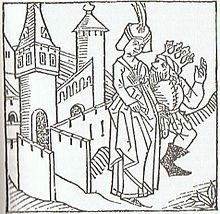Ortnit
He is greatly assisted by the cunning of the dwarf Alberich, who can only be seen by the wearer of a magic ring, and by the martial prowess of the Russian king Ilyas, Ortnit's uncle.
In the second part of the story, Machorel, enraged by Ortnit's abduction of his daughter, sends him, in a feigned gesture of reconciliation, two dragon eggs.
In most of the surviving versions, this is followed by the story of Wolfdietrich, who avenges Ortnit's death and marries his widow.
The bride-quest and dragon motifs come from older oral traditions, but a strong crusading element in the journey to the Levant and defeat of a heathen army reflects the concerns of the 13th century.
With a dozen manuscripts, six printed editions and a theatrical adaptation, the story remained popular right up until the early 17th century.
[7] Version D survives in four different variants from the 15th and 16th centuries: A verse drama in rhyming couplets by Jakob Ayrer published in 1618, Vom dem keiser Ottnit, was er biss and sein Endt erstritten und ausgericht, auff das Getreulichst der Histori nach[9] is based on Ortnit D.[1] Wolfdietrich B is not accompanied by a separate Ortnit tale.
In spite of the fact that Machorel kills any suitor for his daughter, intending to marry her himself once his wife is dead, Ortnit sets his heart on her.
(213–287) Ortnit and his army set sail from Messina and, after 10 days at sea, arrive off the coast of Tyre, Machorel's capital.
Alberich gives Ortnit a magic stone which allows him to speak and understand any language, and this enables him to pose as a merchant to secure permission to dock.
With the battle over, Ilyas is shown a cellar where the remaining heathen warriors are hiding and he beheads all of them in revenge, but Ortnit prevents him from killing the women and children.
(484–526) Machorel is visited by a huntsman, who has stolen two eggs from a dragon's cave and offers to take them to Lombardy to hatch so that they can then devastate Ortnit's land.
(527–575) During an emotional parting from his wife, who tries to dissuade him, Ortnit tells her that if he fails to return, the knight who comes back with his armour, his ring and the dragon's tongue, will have avenged his death.
For two years the queen mourns and, is spite of the urging of the court, refuses to remarry unless it's to the knight who avenges Ortnit.
The story concludes with the remark that we will have to wait a long time for the dragon to be killed, as the killer has not yet been born, he who will later be the grandfather of Dietrich of Verona.
Although the sons threaten to resist violently any claim for tribute, Hugdietrich, in order to save lives, pays in gold.
Ortnit returns home to find his land being terrorised by two dragons and two giants, Velle and his wife Runze.
While the earliest manuscripts of Ortnit date from the 14th century, the language of the poem suggests composition around 1230 in an Upper German dialect.
[11] The name Machorel and the castle of Muntabur seem to be borrowed from the campaign of 1217 in the Fifth Crusade against Sultan al-Malek al-Adel and his fortress at Mount Tabor.
[12] Attempts to derive the story or the figure of Ortnit from Germanic myth or historical personages have not been successful.
[13][14][12] The many German bride-quest stories, which include Ortnit, König Rother, Orendel and Salman und Morolf, have their roots in late Merovingian history: chronicles contain a number of self-contained bride-quest stories, based ultimately on the Frankish King Clovis I's wooing of Clotilde in 492.
The figure of Ortnit's uncle, Ilias, is thought to be derived from the Russian folk hero Ilya Muromets.
[18] Taken together, all these suggest a geographical origin in Northwest Germany, but the story seems to have been constructed from a variety of elements, not simply retelling an "Ortnit-saga".
[20] Ortnit and Wolfdietrich are both written in a strophic form called the Hildebrandston (similar to the Nibelungenstrophe used in the Nibelungenlied and Kudrun).
